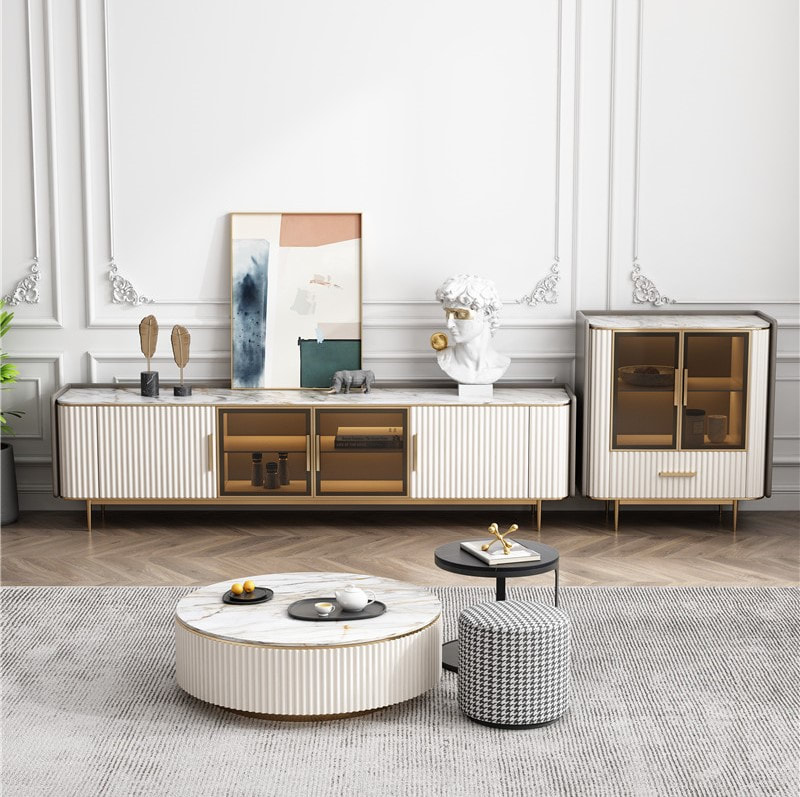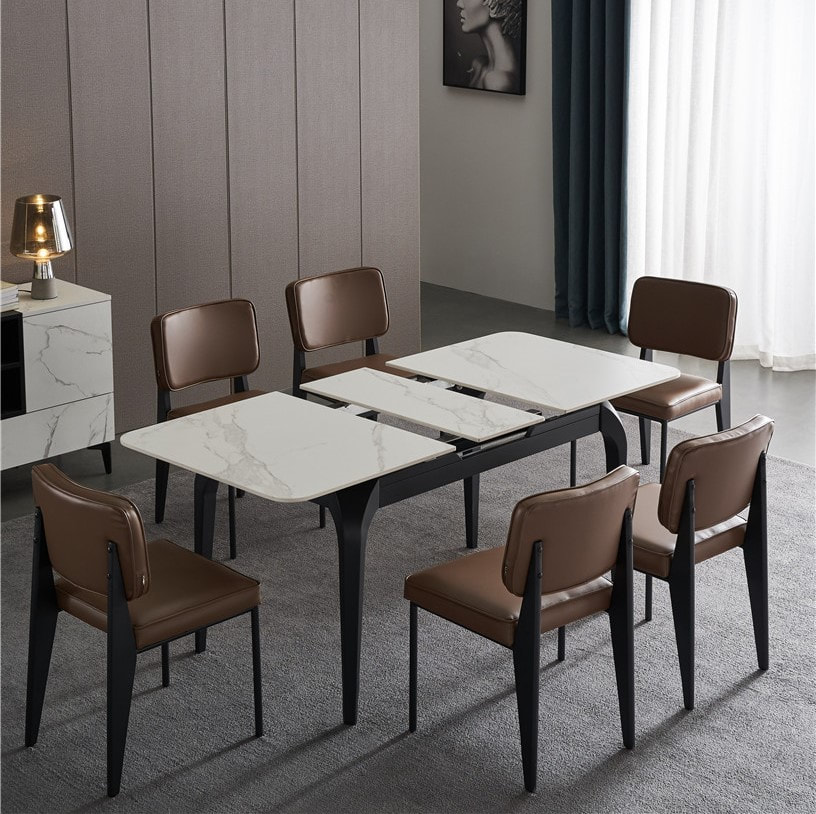As of today, the global pandemic of COVID-19 has not ended. In the winter of economic recovery full of uncertainty and imbalance, we are ushering in 2021. In the past year, the overall performance of the furniture industry in China has been good or even exceeded expectations. And if the timeline is lengthened, the entire Chinese furniture industry may be undergoing certain structural changes, and it is subtly affecting every company and individual involved.
This adjustment did not start last year or a few years ago, but has been ongoing. Key words such as the integration of refined decoration and design of real estate into smart homes, dealer reform,and so on, have increasingly clearly shown the future of China's furniture industry.
Now, let us start with the structural changes in China's furniture industry.
Like the continental plates we live in, they are relatively stable for a long time, but various phenomena such as volcanic eruptions prove that their internal and surface states are not constant. Changes in the furniture industry do not happen suddenly. Changes in the external environment, such as real estate, Internet, population, and other factors, will also bring about adjustments to the internal structure.
Like the continental plates we live in, they are relatively stable for a long time, but various phenomena such as volcanic eruptions prove that their internal and surface states are not constant. Changes in the furniture industry do not happen suddenly. Changes in the external environment, such as real estate, Internet, population, and other factors, will also bring about adjustments to the internal structure.
In the past and in the foreseeable future, what structural changes is the furniture industry going through in China? As an industry expert, Interi Furniture will share some of our observations and thoughts with you today.
Four external variables that are accelerating the transformation and reshaping of China's furniture industry
For a long time, Chinese furniture companies only need to pay attention to their own businesses and peer competitors. Today, these furniture companies may have to look farther and longer. Because the three external forces from upstream real estate , the Internet and smart homes are slowly changing the industry.
1. Three new dimensions of upstream real estate
As the most upstream of the industry, real estate has always profoundly affected all aspects of furniture. For many years, the peak season for real estate sales is also the peak season for furniture sales, although this correlation has gradually weakened in recent years with the decrease in the proportion of new houses and the adjustment of real estate policies.
Another profound impact is that the house structure of real estate is becoming a key research topic for major home furnishing companies in China. It is becoming the consensus of the industry to provide individual furniture products or overall solutions based on house types. And this change is indispensable to the vigorous promotion of many furniture industry associations in China.
In the next few years, upstream real estate will change the furniture industry more profoundly. In our opinion, there are several dimensions worthy of attention.
The first dimension is the rise of the real estate engineering business. With the gradual popularity of full-furnished houses and hard-covered houses, the bulk purchase of building materials and furniture products, especially cabinet furniture, will increase by a large proportion. For custom furniture companies, whether they can withstand a longer billing period, lower profits and large advance costs is the key to determining whether they can undertake this part of the business. Of course, not all customized companies have to do real estate projects. The market share of home decoration is still huge, and the demand for renewal will gradually be released.
Since 2020, the engineering business has driven the excellent performance of the entire Chinese home furnishing sector in the stock market, but as the consumer market has recovered, the popularity of the engineering business has also begun to decline. In fact, the retail market will still be the mainstream in the future, especially for finished furniture. The one-sided focus on engineering business in order to increase revenue may be to quench thirst by drinking poison.
The second dimension is the self-operated furniture and building materials business of China Real Estate Corporation. Many people worry that when real estate giants such as Country Garden and Evergrande also start to make furniture and building materials and even do decoration, how many ways are there for downstream furniture manufacturers? This worry is likely to be magnified anxiety.
On the one hand, compared to the huge value of real estate development and community properties, most real estate giants are not interested in downstream manufacturing, at least not in an important business category. Compared with self-production and self-use, it is more cost-effective to maximize the use of procurement advantages. Even in the home improvement and bag check-in sections, according to our understanding, most Chinese real estate companies are more inclined to charge "entry fees" or set up a separate experimental project team, but progress is often slow or even stagnant due to complex internal relationships .
On the other hand, a small number of Chinese real estate giants, such as Country Garden, are involved in the production of downstream furniture and building materials due to their huge volume. They still meet the core task of "internal circulation", which may squeeze the engineering order market. At the same time, its excess capacity can also be "internally looped" within the industry and become part of its TO B business that is supplied to other real estate projects.
The third dimension is the gradual expansion of the old house market. In China's first-tier cities, the growth of the new house market is approaching the ceiling, especially in Beijing, Shanghai, Guangzhou and Shenzhen. However, the incremental market for house decoration consumption brought about by the renovation of old houses is not only geographically unbalanced.For example, it is also a first-tier city, where the proportion of old houses in Shanghai far exceeds that of Guangzhou; the outbreak of its market will be more scattered in time, and measures must be adapted to local conditions.
2. The structural transformation of the furniture industry by Chinese Internet e-commerce giants
News like Alibaba and Xiaomi "invaded" the home furnishing industry, often triggering anxiety in the furniture industry. But the "wolf is coming" story has been shouting for many years. Except for the negative impact caused by Double Eleven, the actual progress is very small, but it also brings more complementary and mutually reinforcing results. Chinese Internet companies have transformed the furniture industry in many ways, but the main thing is the transformation of shopping experience, logistics efficiency and thinking mode.
From the perspective of e-commerce, the online shopping experience of Chinese furniture has been greatly improved in the past five years, which has driven the rise of a number of furniture industry bases such as Nankang, and has also allowed Internet thinking to initially enter the traditional furniture industry. However, the in-depth integration of e-commerce and the furniture industry will still have to overcome the problem of online and offline synergy in the future, that is, "new retail".
Benefiting from the rapid development of e-commerce, the logistics efficiency of Chinese furniture has been greatly improved, and the difficulty of last-mile service has been basically overcome. This in turn has promoted the business growth of a number of offline Chinese furniture companies, which can be said to be a windfall.
The most important thing is actually the transformation of the "thinking mode" of Chinese furniture companies by the Internet. Chinese furniture companies pay attention to "dealer experience", while e-commerce pursues the ultimate "user experience", so many new changes have been brought about in product development, service methods, and marketing methods. In addition, traditional Chinese furniture companies rely mainly on experience and perception in product development and market operations, and it is difficult to interact with consumers. The most important thing is actually the transformation of the "thinking mode" of Chinese furniture companies by the Internet. Chinese furniture companies pay attention to "dealer experience", while e-commerce pursues the ultimate "user experience", so many new changes have been brought about in product development, service methods, and marketing methods. In addition, traditional Chinese furniture companies rely mainly on experience and perception in product development and market operations, and it is difficult to interact with consumers. The biggest feature of e-commerce is the emphasis on "data" and direct interaction with consumers.
In the next few years, the transformation of the Chinese furniture industry by the Internet and e-commerce will further penetrate into all links of the industrial chain. A typical example is Ali Lieping, striving to open up the service chain of "design-production-consumption". The exploration of private housing decoration industry by "quasi-Internet companies" such as Suning and Gome may accelerate the integration of furniture and home appliances.
3. To watch or merge? The new relationship between smart home and Chinese furniture industry
A question that needs to be solved in the Chinese furniture industry is that in the future smart home era, should furniture companies participate? How to participate?
There is an idea that may be worth learning. That is, Chinese furniture companies and smart homes act as carriers for each other, deeply embedded or even integrated. In the future, Chinese furniture companies and smart equipment vendors will work together to develop smart home products for specific consumer groups such as children and the elderly, or in special scenarios such as travel, entertainment and office, and achieve innovative iterations of traditional furniture companies. In the field of high-end customized furniture, smart furniture is becoming a part of the overall solution of furniture companies' brand, but it will take time to test the distance to complete integration.
Smart sleep (smart bed or smart mattress) can also be said to be the prototype of this model. At the Shenzhen International Furniture Fair in 2020, a number of leading software furniture companies have launched smart bed related products, through the application of smart sensor related technology to achieve humanized sleep. In addition, Shenzhen International Furniture Fair has also joined hands with Huawei Smart Selection to create a "high-end customized HiLlink Smart Home Pavilion" to promote the in-depth integration of the furniture industry and the smart home field
4. Changes in the consumption structure are forcing the Chinese furniture industry
Although many changes have taken place on China's supply side, the "consumer traction" is also very important. For today's Chinese furniture industry, the overall migration of consumer groups is more intense and straightforward than before. Looking around at many home furnishing stores, products that were still very popular three or five years ago are rarely asked today. Behind this is the generational transformation and aesthetic iteration of the consumer population.
Contemporary young people in China are more inclined to fashion and lightweight design, and pay more attention to experience in consumption scenes, whether online or offline. In the long run, the trend of Chinese furniture consumption will generally follow the path of developed countries. A Chinese furniture industry expert summarized the global furniture consumption trend in the past 100 years, which can be roughly summarized as the evolution path of "functionalism-aesthetics (style)-semantics (emotion)".
In addition, the implementation of the Chinese government's two-child policy has led to the outbreak of related categories such as children's tables and chairs. Internet media and mobile social networking have gradually "re-tribalized" the social population—the niche cultural circle labeled with hobbies and hobbies will grow stronger and become another noteworthy phenomenon in mainstream culture and consumer circles. For example, in recent years, including industrial style, Japanese minimalist style, are representatives of niche fashion, and promote the development of China's segmented furniture market.









